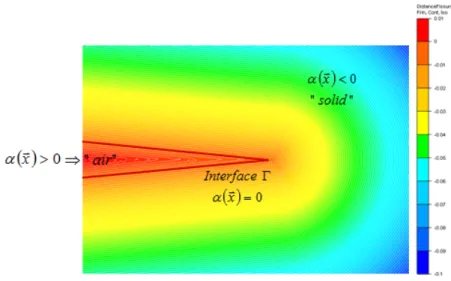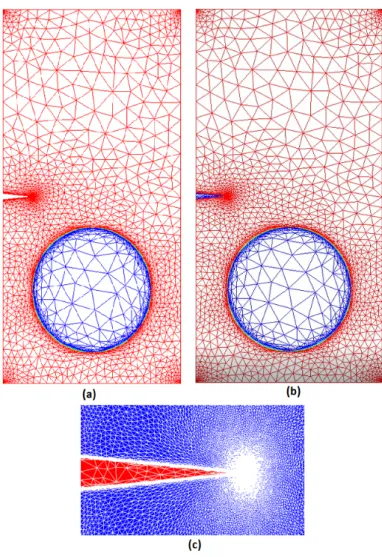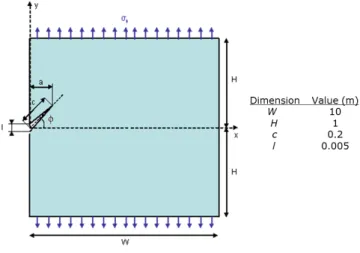HAL Id: hal-01731909
https://hal-mines-paristech.archives-ouvertes.fr/hal-01731909
Submitted on 14 Mar 2018
HAL is a multi-disciplinary open access
archive for the deposit and dissemination of
sci-entific research documents, whether they are
pub-lished or not. The documents may come from
teaching and research institutions in France or
abroad, or from public or private research centers.
L’archive ouverte pluridisciplinaire HAL, est
destinée au dépôt et à la diffusion de documents
scientifiques de niveau recherche, publiés ou non,
émanant des établissements d’enseignement et de
recherche français ou étrangers, des laboratoires
publics ou privés.
A novel monolithic Lagrangian approach for modelling
crack propagation using anisotropic mesh adaptation
Karim Hitti, Stephanie Feghali, Faten Rafeh, Marc Bernacki, Pierre-Olivier
Bouchard
To cite this version:
Karim Hitti, Stephanie Feghali, Faten Rafeh, Marc Bernacki, Pierre-Olivier Bouchard. A novel
mono-lithic Lagrangian approach for modelling crack propagation using anisotropic mesh adaptation.
Inter-national Journal of Advances in Applied Mathematics and Mechanics, Earliest publisher: Surat: Dept.
of Mathematics Sarvajanik College of Engineering & Technology 2018, 5 (3), pp.53-65. �hal-01731909�
Journal homepage:www.ijaamm.com
International Journal of Advances in Applied Mathematics and Mechanics
A novel monolithic Lagrangian approach for modelling crack
propagation using anisotropic mesh adaptation
Research Article
Karim Hittia,∗, Stéphanie Feghalib, Faten Rafehc, Marc Bernackid, Pierre-Olivier Bouchardd
aDepartment of Mathematics, Faculty of Sciences and Issam Fares Faculty of Technology, University of Balamand, Lebanon bLebanese University, Faculty of sciences II, Mathematics Department, P.O. Box 90656 Fanar-Matn, Lebanon
cDepartment of Civil Engineering and Construction, Issam Fares Faculty of Technology, University of Balamand, Lebanon
dMines-ParisTech, PSL-Research University, CEMEF - Centre de mise en forme des matériaux, CNRS UMR 7635, CS 10207 rue Claude Daunesse,
06904 Sophia Antipolis Cedex, France
Received 17 January 2018; accepted (in revised version) 23 February 2018
Abstract: A monolithic Lagrangian finite element method is explored to model crack propagation. This approach is based on the level-set method coupled with anisotropic remeshing to define the crack faces and tip. Moreover, the Gθ method is used for computing the strain energy release rate and the propagation direction. Furthermore, a new technique for computing the convection velocity, which is a mixture between the propagation speed and the mechanical velocity, is introduced.
MSC: 74R99 • 74S05
Keywords: Crack propagation • Mesh adaptation • Gθ method • Monolithic approach • Lagrangian framework
© 2018 The Author(s). This is an open access article under the CC BY-NC-ND license(https://creativecommons.org/licenses/by-nc-nd/3.0/).
1. Introduction
Since the last century, a large number of theories and applications have been developed to deal with fracture me-chanics and crack propagation [1–8]. The latter gives rise to many difficulties since it leads to an important displace-ment discontinuity. The Finite Eledisplace-ment Method (FEM) [4,5,9] has proved its efficiency in dealing with crack propa-gation by modifying the mesh’s topology and performing automatic remeshing [4,5,10–14].
Nevertheless, several remeshing-free methods have been proposed: Belytschko has suggested the Element free Galerkin method [3] where the discretisation is achieved by nodal and surface description of the model. The Strong Discontinuity Approach (SDA) [15–17] in which displacement jumps due to the presence of the crack are embedded locally in each cracked finite element without affecting neighbouring elements. The Extended Finite Element Method (XFEM) [18–20] in which the displacement-based approximation is enriched near a crack by incorporating both dis-continuous fields and the near tip asymptotic fields through a Partition of Unity method [21]. The arbitrary local mesh replacement method [22] based on two distinct meshes: one that surrounds the propagating crack front and moves with it, and the other one that fills the rest of the domain. However, these methods need improvement in order to
∗ Corresponding author.
E-mail address(es): karim.hitti@balamand.edu.lb (Karim Hitti), stephanie.elfeghali@gmail.com (Stéphanie Feghali), faten.rafeh@balamand.edu.lb(Faten Rafeh),marc.bernacki@mines-paristech.fr(Marc Bernacki), pierre-olivier.bouchard@mines-paristech.fr(Pierre-Olivier Bouchard).
properly deal with long crack propagation and crack coalescence such as the XFEM. Or also complex configurations such as the Element free method, and multiple cracks such as the arbitrary local mesh replacement method. And some of them, like the XFEM, would eventually need some type of remeshing.
Hence, remeshing techniques are important when dealing with crack propagation. Chiaruttini et al. [10] used remeshing along with the Cohesive Zone Model (CZM) to simulate crack propagation in structures subjected to mixed mode loadings. Furthermore, 3D remeshing techniques were used to model properly crack propagation us-ing the computation of a damage indicator [11] or also based on mesh intersection algorithms [12]. Two and three-dimensional remeshing, via the fracture numerical code FRANC [13,14], were also used to simulate crack growth. Remeshing, combined with nodal relaxation, was developed and used by Bouchard et al. [4,5] and it has proven its efficiency when dealing with complex and multiple crack propagations.
Furthermore, monolithic approaches, which consist in using a unique mesh for the different components, are widely used in various domains. Notably in fluid-structure interaction [23], heat transfer [24], incompressible fluid flows [25], microstructures’ behaviour [26,27]. In all the above-cited applications, the monolithic approach proved its efficiency. Hence, studying its feasibility in crack propagation is proposed in this paper. In this context, two frame-works, the Eulerian and Lagrangian can be compared. The Eulerian framework consists in describing the crack im-plicity using a level-set function and thus the air inside the crack is taken into account in the governing equations. Also this level-set function must be convected at each time step in order to simulate its propagation. On the other hand, in the Lagrangian framework the crack is explicitly described by nodes of the mesh and its propagation is performed by moving these nodes, and remeshing.
In this paper, a method for modelling quasi-static crack propagation using level-set functions, anisotropic remesh-ing and a novel method for choosremesh-ing the convection velocity is introduced. In the second section, the level-set method and the anisotropic remeshing technique are explained. Also the Gθ method used for computing the energy release rate along with the kinking angle is detailed. Section 3 introduces our method for computing the convection velocity of the crack. A comparison between results in an Eulerian and a Lagrangian framework is performed. Then the better one is compared with Bouchard et al.’s [5] technique. The fourth section concludes this paper.
All numerical calculations mentioned in this paper were performed with CimLib, a finite element C++ library [28].
2. Numerical modelling
2.1. Level-set and mesh adaptation
In the perspective of modelling crack propagation, a monolithic approach is used. The monolithic method consists of using a unique mesh in which the different domains are considered using a level-set function. Moreover a level-set function is a signed distance functionα, defined over the domain Ω, that gives at any node X of coordinates x of the FE mesh the signed distance to the boundaryΓ. In turn, the interface Γ is given by the level 0 of the function α:
(α(x) = ±d(x,Γ),x ∈ Ω
Γ = {x ∈ Ω,α(x) = 0} (1)
Fig. 1illustrates the level-set function of a crack.
Consequently, different structures are immersed in a larger domain of different material properties so that bound-ary conditions at the interface can be replaced naturally. Furthermore, the level-set function, defining the interface, is used to mix the different material properties using appropriate mixing laws [26,29]. Moreover, this function is used for meshing and remeshing operations in order to describe properly the considered interface and also to account for the discontinuities of the physical properties. Mesh adaptation is also needed at the crack tip to insure the computational accuracy of the singular fields. It has to be noted that, contrary to XFEM, these singular fields are not imposed in the shape functions of the elements containing the crack tip.
To this end, it is crucial to pre-adapt anisotropically the mesh at the materials’ interface, the crack faces and tip. By doing so, the mesh becomes locally refined, elements are stretched, which enables to sharply define the interface and to save a great number of elements compared to classical local isotropic refinement. This anisotropic adaptation is performed by constructing a metric map. This map is controlled by a directional error estimator based on local inter-polation error of the wanted fields which are in this case the level-set functions defining the interface, the crack faces and the pressure field. Furthermore, in our case, different metrics are obtained, one for each field. The intersection of these metrics [30] leads to the one used for mesh adaptation.
In the aim of constructing these metrics, an a posteriori error estimator [31] is used. This error estimator uses the eigenvalues and eigenvectors of the recovered Hessian matrix of a given function and a wanted number of elements in order to construct the metric field. In practice, the mesh is generated in several steps using the MTC mesher and remesher developed in [32]. The proposed mesh generation algorithm works well for 2D or 3D complex shapes. It allows the creation of meshes with extremely anisotropic elements stretched along the interfaces. The mesh size is then only refined in the direction of the high physical and mechanical properties gradients. This allows conserving a high accuracy for describing properly mechanical fields and geometry description. During propagation, the mesh is only modified in the vicinity of the interface and near the crack tip which keeps the computational work devoted to the mesh generation low.
Since we will begin by comparing our method in Eulerian and Lagrangian frameworks and the better approach with the one in [5],Fig. 2shows the result of the mesh adaptation technique on the construction of the initial mesh of the comparison case, which is a pre-cracked rectangular region with an off-center inclusion. Here anisotropic remeshing was applied using the level-set functions of the crack and the disc along with the pressure which is maximal at the crack tip.
2.2. Computing the strain energy release rate
The strain energy release rate G represents the energy required for a unitary crack increase. The criterion states that among all virtual and kinematically admissible crack propagation directions, the real increase is the one which maximizes the strain energy release rate. The kinking angle,θ0, is then determined by:
³ dG dθ ´ θ=θ0= 0 ³ d2G dθ2 ´ θ=θ0≤ 0 (2)
Numerous numerical techniques can be used to compute G [5]. In this study, the Gθ method [33] is used. It consists in defining two contours C1and C2around the crack tip. These contours divide the domain near the crack tip into
three sub-domains: Cext, Cr i ngand Ci nt(seeFig. 3).
Afterwards, the strain energy release rate computation is performed by solving:
G = Z Cr i ng · Tr (σ∇u∇Θ) −1 2Tr (σ∇u)∇.Θ ¸ dCr i ng. (3)
where Tr (.) is the trace operator, σ is the stress tensor, u is the displacement field, and Θ(θ1,θ2) is a virtual unit
displacement field that may be expressed as:
θ1= (1 −I MI J )cos(θ) θ2= (1 −I MI J )si n(θ) (4)
Therefore, this virtual fieldΘ modifies only the shape of elements belonging to Cr i ng. The computation of G is
performed in the Cr i ng area and a strain energy release rate G can be computed for each possible direction of crack
Fig. 2.Anisotropic meshing adaptation based on an a posteriori error estimation: a) in the Lagrangian framework, b) in the Eulerian framework and c) zoom at the crack tip
Fig. 3.Contours and domains used to compute G with the Gθ method [5]
2.2.1. Comparison with analytical values
The Gθ method has been implemented in CimLib [28]. At each crack increment, G is computed forθ varying from −70oto 70owith 1osteps. G’s curve is increasing and then decreasing (seeFig. 4) so that the determination of the angleθ0corresponding to the maximum strain energy release rate is straightforward.
In order to validate our implementation and use the Gθ method for computing strain energy release rates, two comparisons with known analytical results were performed. The first with a single edge crack (seeFig. 5for details and dimensions) and the second for a slant crack (seeFig. 6for details and dimensions)
In the case of the single edge crack (Fig. 5), the strain energy release rate is G = KI2/E where E is the Young modulus and KI, the stress intensity factor in mode I, is given by [34]:
KI= σnF
p
Fig. 4.Curve of G as a function ofθ in case of a single edge crack
Fig. 5.Domain and dimensions used in the single edge crack case
Fig. 6.Domain and dimensions used in the slant crack case
with F = 1.0174/λ3/2whereλ = 1 − aW and σn, the normal stress, taken to be 50M P a.
Analytically, G = 5.31 × 10−3N /m and the obtained numerical result was G = 5.4 × 10−3N /m In the case of the slant crack, G =(K
2 I+K
2 I I)
E where KIand KI I(the stress intensity factor in mode II) are given by [34]:
KI ,I I= σnFI ,I I
p
πc (6)
with
FI I' 0.4741si n(1.4675φ) (8)
whereφ = 45oandσnalso taken to be 50M P a.
Analytically, G = 6.6 × 10−3N /m and the obtained numerical result was 6.45 × 10−3N /m
These results validate our implementation and use of the Gθ method for computing strain energy release rate and hence the kinking angle.
3. Convection velocity
3.1. Mechanical equations
After mixing the different material properties, the incompressible Stokes equations modelling the mechanical problem are solved using a stabilized mixed FE method and a P1+/P1 interpolation. These equations can be writ-ten: µ∆v − ∇p = −g on Ω ∆.v = 0 v = vimp on Γu v = −vimp on Γl (9)
where v is the velocity, p the pressure, g the gravity,Ω is the computational domain, and µ = 1+νE is the first Lamé coefficient where E is Young’s Modulus andν is Poisson’s ratio. Also vimpis the imposed velocity onΓuandΓlwhich
are the upper and lower boundaries of the domain respectively. 3.2. Computation of the convection velocity
After obtaining the velocity and the pressure fields from the mechanical problem, the computation of G infers the calculations of the propagation direction,θ0and hence the speed at the crack tip, ˙a which can be written [35]:
˙ a =( 0 i f G < Gc cR q 1 −KIc KI ot her w i se (10)
This speed is greater than zero only if G ≥ Gcwhich is the fracture energy in function of KIc, the fracture toughness; cRis the Rayleigh wave speed. Hence, a velocity around the crack tip, vc t, can be given by:
vc t= ˙a(cosθ0, si nθ0). (11)
This velocity insures the proper propagation of the crack but not the crack opening. The latter can be insured by the mechanical velocity, v. These facts lead us to use a Lagrangian convection velocity which is the combination of vc t
and v. This convection velocity, denoted vconvec, is given by:
vconvec=
(v i f ˙
a = 0 ⇐⇒ G < Gc
vc t(H (β)) + v(1 − H(β)) i f a 6= 0 ⇐⇒ G ≥ G˙ c
(12)
whereβ is the level-set function of a small circle centered at the crack tip and H(β) a smoothed Heaviside function used for mixing the different velocities on a certain predefined thickness.
3.3. Results
In all the below-studied cases, anisotropic mesh adaptation is performed, at each time step, to maintain proper propagation and computation of the singular fields at the crack tip. Hence each time step can be illustrated by the scheme inFig. 7.
Moreover, a rectangular domain with an off-center circular inclusion described inFig. 8will be used in all the comparative cases.
Fig. 7.The scheme of a time step
Fig. 8.The domain of the comparative case
3.3.1. Comparison between Eulerian and Lagrangian
Before comparing our method with another one, a choice between the Eulerian and Lagrangian frameworks has to be maid. Hence, two crack propagation cases (one in each framework) in which the circular inclusion in the pre-described domain is less rigid than the matrix, were performed.Fig. 9shows the comparison between the two
frame-Fig. 9.Comparison between the Lagrangian and Eulerian framework during crack propagation: a) the Lagrangian one and b) the Eulerian one
works at different time steps.
In this case, according to Bouchard et al. [5], the crack has to be drawn by the inclusion but not to the point of intersection. It can be seen that using a Lagrangian framework, the crack moves away from the inclusion before hitting it which is not the case in the Eulerian framework. This is due to the fact that in an Eulerian framework a level-set function defines the crack and this function needs to be convected or transported at each time step in order to simulate the propagation.
This type of convection is very delicate because it is largely affected by the mesh size and the time step and since the level-set function would, in general, loose its characteristic as a distance function and has to be reinitialized. This is problematic when the remeshing technique depending on the distance property is used at the interface. Further details can be found in [36]. A solution to this problem might lie in the use of the direct reinitialization technique [37]. It consists in discretizing the interface (isozero of the level-set function) into a collection of simple elements and, for every node, computing the distance to all elements of the collection and storing the smallest one which becomes the updated value of the distance function. This method was considered very time consuming [38] but efficient parallel implementation and computation reduced drastically its computational times [37].
Also capturing accurately the crack tip via a level-set function is very hard since it may lie inside an element of the mesh (seeFig. 10) unless extreme refinement near the tip which, on the other hand, would lead to expensive computational times.
Body-fitted meshing [39] used for analysis of void growth and coalescence could be a solution if used near the crack tip. It consists on defining the interface (the isozero of the level-set) by nodes of the mesh and redefining this interface after convection using body-fitted remeshing. In our case, this might solve the problem of capturing the crack tip since it would be a node of the finite element mesh.
Furthermore, in our case, in addition to the level-set defining the crack, a level-set function defining the circle used for mixing the velocities near the crack tip is used. This circle needs also to be displaced along with the crack tip which make things more complicated because any small difference in the velocity at neighboring nodes might lead to misplacement of this circle.Fig. 11shows the case where the circle is convected faster than the crack leading to an unusual propagation of the crack.
Fig. 10.(a) The fine mesh near the tip (b) the inaccurate definition of the level-set function defining the crack at the tip
Since working in a Lagrangian framework was less complicated and lead to better results than an Eulerian one, the following case will be based on the Lagrangian one. It is important to mention that working in the Eulerian framework could eventually give good results if explored furthermore but surely needs extreme remeshing especially near the crack tip or needs the use of one of the above-mentioned possible solutions. On the other hand, working in the Eulerian framework might be necessary for some applications notably the hydraulic fracking [40,41] where a fluid is present inside the crack and its pressure on the crack’s faces needs to be computed.
3.3.2. Comparison with Bouchard et al. [5]
Our method, in the Lagrangian framework, is compared with a case presented in [5] (seeFig. 8). The influence of this inclusion on the crack path is studied. The rectangular domain was submitted to a tensile test. The circular inclusion may be more or less rigid than the matrix. R is defined as the ratio of the matrix and inclusion’s Young modulus: R = Emat r i x/Ei ncl.
Figs. 12and13illustrate the comparison between our method and Bouchard et al.’s [5]. Fig. 12shows that for an inclusion less rigid than the matrix (R = 10), the crack is attracted to the inclusion. Conversely, if the inclusion is more rigid than the matrix (R = 0.1,Fig. 13), the crack is moving away from the inclusion.
Fig. 13.Comparison between our method and the one in [5] for R = 0.1: a) Results of [5] and b) our results
Both figures show a very good agreement between the two methods. This validates that our technique computes the strain energy release rate and the kinking angle in a proper manner. Furthermore, our choice of Lagrangian con-vection velocity models correctly crack propagation.
4. Conclusion
A monolithic method was introduced to model crack propagation. This process is based on the use of level-set functions for interface description, on anisotropic mesh adaptation and on the choice of an appropriate convection velocity. The latter is a combination between the mechanical velocity and the speed at the crack tip. This speed is linked to the strain energy release rate which was computed by the Gθ method along with the kinking angle.
Furthermore, in the monolithic method, two frameworks, the Eulerian and Lagrangian, were compared. In our case, working in the Lagrangian framework was less complicated since it needed less remeshing and since the crack was convected naturally with the mesh. Also since in the Eulerian framework, extremely fine meshes are needed to properly describe the crack faces and tip. And the crack, described implicitly by a level-set function, is hard to convect. Moreover, our monolithic Lagrangian method proved its efficiency in correctly modelling the propagation of the crack after comparing it with the method in [5]. Nevertheless, the Eulerian framework might be essential in some applications like the the hydraulic fracking in order to take the fluid inside the crack into consideration. A solution to the weak points of the Eulerian framework could be in using a body-fitted immersed volume method at the crack tip as described in [39] or also in use of direct reinitialization [37] to solve the problem of level-set convection.
References
[1] A.A. Griffith, The phenomena of rupture and flow in solid, Phil. Trans. Roy. Soc. London A 221 (1920) 163-197. [2] G.R. Irwin, D.C. Washington, Analysis of stresses and strains near the end of a crack traversing a plate, J. Appl.
Mech. (1957) 361-364.
[3] T. Belytschko, Y.Y. Lu, L. Gu, Element free Galerkin methods, Int. J. Numer. Methods Engrg 37 (1994) 229-256. [4] P.-O. Bouchard, F. Bay, Y. Chastel, I. Tovena, Crack propagation modelling using an advanced remeshing
tech-nique, Methods Appl. Mech. Engrg 189 (2000) 723-742.
[5] P.-O. Bouchard, F. Bay, Y. Chastel, Numerical modelling of crack propagation: automatic remeshing and compar-ison of different criteria„ Computer methods in applied mechanics and engineering (2003) 3887-3908.
[6] P.-O. Bouchard, M. Bernacki, D. M. Parks, Analysis of stress intensity factors and T-stress to control crack propa-gation for kerf-less spalling of crystal silicon foils, Comp. Mat. Sc. 69 (2013) 243-250.
[7] A. Sur, M. Kanoria, Analysis of thermoelastic response in a functionally graded infinite space subjected to a Mode-I crack, Mode-Int. J. Adv. Appl. Math. and Mech. 3(2) (2015) 33-44.
[8] R. Patraa, S. P. Barikb, P. K. Chaudhuri, An internal crack problem in an infinite transversely isotropic elastic layer, Int. J. Adv. Appl. Math. and Mech. 3(1) (2015) 62-70.
[9] N. J. Noon, Fully discrete formulation of Galerkin-Partial artificial diffusion finite element method for coupled Burgers’ problem, Int. J. Adv. Appl. Math. and Mech. 1(3) (2014) 56-75.
[10] V. Chiaruttini, D. Geoffroy, V. Riolo, M. Bonnet, ,An adaptive algorithm for cohesive zone model and arbitrary crack propagation, Revue Européenne de Mécanique Numérique/European Journal of Computational Mechan-ics 21 (2012) 208-218.
[11] H. Proudhon, J. Li, F. Wang, A. Roos, V. Chiaruttini, S. Forest, 3D simulation of short fatigue crack propagation by finite element crystal plasticity and remeshing, Int. J. of Fatigue 82 (2016) 238-246.
[12] V. Chiaruttini, V. Riolo, F. Feyel, Advanced remeshing techniques for complex 3D crack propagation, in: 13th International Conference on Fracture, Beijing, China, 2013.
[13] T. Bittencourt, P. Wawrzynek, J. Sousa, A. Ingraffea, Quasi-automatic simulation of crack propagation for 2D LEFM problems, Engrg. Fract. Mech. 55 (2) (1996) 321-334.
[14] B.J. Carter, P.A. Wawrzynek, A.R. Ingraffea, Automated 3D crack growth simulation, Gallagher Special Issue of Int. J. Numer. Methods Engrg. 47 (2000) 229-253.
[15] J.C. Simo, J. Oliver, F. Armero, An analysis of strong discontinuities induced by strain softening in rate dependent inelastic solids, Int. J. Numer. Methods Engrg. 12 (1993) 277-296.
[16] K. Garikipati, On strong discontinuities in inelastic solids and their numerical simulations, Ph.D. Thesis, Stanford University, 1996.
[17] J. Oliver, Continuum material failure in strong discontinuity settings, in: E. Oñate, D.R. Owen (Eds.), COMPLAS 2003, VII International Conference on Computational Plasticity, CIMNE, Barcelona, 2003.
[18] T. Belytschko, T. Black, Elastic crack growth in finite elements with minimal remeshing, Int. J. Numer. Methods Engrg. 45 (1999) 601-620.
[19] N. Moës, J. Dolbow, T. Belytschko, A finite element method for crack growth without remeshing, Int. J. Numer. Methods Engrg. 46 (1999) 131-150.
[20] N. Moës, E. Bechet, Modeling stationary and evolving discontinuities with finite elements, in: E. Oñate, D.R. Owen (Eds.), COMPLAS 2003, VII International Conference on Computational Plasticity, CIMNE, Barcelona, 2003. [21] I. Babuska, J.M. Melenk, The partition of unity method, Int. J. Numer. Methods Engrg. 40 (1997) 727-758. [22] M.M. Rashid, he arbitrary local mesh replacement method: an alternative to remeshing for crack propagation
analysis, Comput. Methods Appl. Mech. Engrg. 154 (1998) 133-150.
[23] E. Hachem, S. Feghali, R. Codina, T. Coupez, Anisotropic adaptive meshing and monolithic Variational Multiscale method for fluid-structure interaction, Comp. and Struc. 122 (2013) 88-100.
[24] E. Hachem, G. Jannoun, J. Veysset, M. Henri, R. Pierrot, I. Poitrault, E. Massoni, T. Coupez, Modeling of heat transfer and turbulent flows inside industrial furnaces, Sim. Mod. Practice and Theory 30 (2013) 35-53.
[25] T. Coupez, G. Jannoun, N. Nassif, H.C. Nguyen, H. Digonnet, E. Hachem, Adaptive time-step with anisotropic meshing for incompressible flows, J. of Comp. Phys. 241 (2013) 195-211.
[26] K. Hitti, T. Coupez, M. Bernacki, L. Silva, Elastic foam compression in a finite element (FE) context, European Journal of Computational Mechanics (2012) 1-29.
[27] K. Hitti, S. Feghali, M. Bernacki, Permeability computation on a Representative Volume Element (RVE) of unidi-rectional disordered fiber arrays, Journal of Computational Mathematics 34 (3) (2016) 233-239.
[28] H. Digonnet, L. Silva, T. Coupez, Cimlib: a fully parallel application for numerical simulations based on compo-nents assembly, Proceedings NUMIFORM 07, American Institute of Physics, p. 269, 2007.
[29] E. Hachem, Stabilized finite element method for heat transfer and turbulent flows inside industrial furnaces, PhD thesis, Ecole Nationale Supérieure des Mines de Paris, 2009.
[30] F. Alauzet, P.J. Frey, Estimateur d’erreur géométrique et métriques anisotropes pour l’adaptation de maillage. Partie I : aspects théoriques, Internal Report, INRIA, 2003.
[31] Y. Mesri, W. Zerguine, H. Digonnet, L. Silva, T. Coupez, Dynamic parallel adaption for three dimensional un-structured meshes: application to interface tracking, Proceedings of the 17th International Meshing Roundtable, 195-212, 2008.
[32] T. Coupez, Génération de maillage et adaptation de maillage par optimisation locale, Revue européenne des éléments finis 9 (2000) 403-423.
[33] P. Destuynder, M. Djaoua, S. Lescure, Quelques remarques sur la mécanique de la rupture élastique, Journal de Mécanique Théorique et Appliqué 2(1) (1983) 113-135.
[34] T. Fett, Stress Intensity Factors - T-Stresses - WeightFunctions. Supplement Volume, Universitatsverlag Karlsruhe, Karlsruhe, 2010.
[35] M. F. Kanninen, C. H. Popelar, Advanced Fracture Mechanics, Oxford University Press, 1985.
[36] L. Ville, L. Silva, T. Coupez, Convected level set method for the numerical simulation of fluid buckling, Int. J. Numer. Meth. Fluids 66 (2011) 324-344.
[37] M. Shakoor, B. Scholtes, PO. Bouchard, M. Bernacki, An efficient and parallel level set reinitialization method -Application to micromechanics and microstructural evolutions, Appl. Math. Modelling 39 (23) (2015) 7291-7302. [38] R. N. Elias, M. A. D. Martins, A. L. G. A. Coutinho, Simple finite element-based computation of distance functions
in unstructured grids, Int. J. Num. Met. in Eng. 72 (9) (2007) 1095-1110.
[39] M. Shakoor, M. Bernacki and P.-O. Bouchard, A new body-fitted immersed volume method for the modeling of ductile fracture at the microscale: analysis of void clusters and stress state effects on coalescence, Eng. Fract. Mec. 147 (2015) 398-417.
[40] Chenpeng Song, Yiyu Lu, Hongmei Tang, Yunzhong Jia, A method for hydrofracture propagation control based on non-uniform pore pressure field, J. of Natural Gas Science and Engineering 33 (2016) 287-295.
[41] Xiaguang Zeng, Yujie Wei, Crack deflection in brittle media with heterogeneous interfaces and its application in shale fracking, J. of the Mechanics and Physics of Solids 101 (2017) 235-249.
Submit your manuscript to IJAAMM and benefit from: I Rigorous peer review
I Immediate publication on acceptance
I Open access: Articles freely available online
I High visibility within the field
I Retaining the copyright to your article
————————————————————————————— Submit your next manuscript atI editor.ijaamm@gmail.com






![Fig. 12. Comparison between our method and the one in [5] for R = 10: a) Results of [5] and b) our results](https://thumb-eu.123doks.com/thumbv2/123doknet/11585721.298363/11.892.267.618.363.945/fig-comparison-method-r-results-b-results.webp)
![Fig. 13. Comparison between our method and the one in [5] for R = 0.1: a) Results of [5] and b) our results](https://thumb-eu.123doks.com/thumbv2/123doknet/11585721.298363/12.892.267.618.80.700/fig-comparison-method-r-results-b-results.webp)